- Home
- New Kyurizukai
- Quantum-Mechanical Optoelectronics
from Keio's Faculty of Science and Technology
Quantum-Mechanical Optoelectronics
from Keio's Faculty of Science and Technology
New horizons of optoelectronics opened up
by quantum mechanics.
Requisite for pursuit of research are a challenger spirit and the ability to concentrate.
Dr. Hayase is one of the few female researchers in Japan specializing in quantum-mechanical optoelectronics. Though it is difficult to imagine from her soft and gentle appearance and manners, as a high school student she belonged to her school’s rowing club and was powerful enough to place fourth in the national high-school competition. Using her bodily strength and power of concentration nurtured through club activities, Dr. Hayase has forged her own way as a researcher.
Junko Hayase
Dr. Hayase’s specialty is quantum optoelectronics. Specifically, she engages in studies regarding optical properties of nanostructured semiconductors based on the use of ultrashort light pulses, quantum control, and application of quantum information. Ms. Hayase acquired a doctor’s degree (science) at Sophia University. Before being assigned to the current position as an associate professor of Keio University’s Faculty of Science and Technology in 2010, Dr. Hayase served as a fellow researcher at RIKEN’s basic science laboratory, a fellow researcher at the National Institute of Information and Communications Technology (NICT),
a researcher at the Japan Science and Technology Agency’s (JST) “PRESTO (Sakigake)” system, and a research associate professor at the University of Electro-Communications’ Education and Research Center for Advanced Studies. In 2009, she was awarded the “Young Scientist’s Prize” by the Minister of Education, Culture, Sports, Science and Technology.
Introducing Researchers
Featured in this issue is Associate Professor Junko Hayase, who is in pursuit of a quantum leap in the innovation of informatics. Associate Professor Hayase strives toward realizing practical use of quantum-mechanical optoelectronics.
Applying principles of quantum mechanics to semiconductors and photonics
Possibility of “A world with 0 and 1 used simultaneously”
In the extreme micro-world of atoms, molecules, electrons and elementary particles, phenomena that cannot be explained by classical mechanics often take place. This is the field of study quantum mechanics handles. A century has passed since the theory of quantum mechanics was established. As its correctness is verified through experiments, quantum mechanics has made rapid progress and grown into a technology within the reach of humankind for practical use. Associate Professor Hayase is tackling the practical application of quantum-mechanical optoelectronics by pioneering technologies to control quantum-mechanical characteristics of light and semiconductors.
Creating new technology by combining pulsed light and semiconductors
“Quantum-mechanical informatics is a focus of attention today as the greatest application of quantum mechanics. Effective and advanced use of quantummechanical characteristics enables many wonderful things that conventional informatics couldn’t even imagine previously – things, such as quantum teleportation capable of communicating information to remote places in an instant; a quantum computer that can solve extremely demanding tasks in an instant via super-parallel computing – a task that would take hundreds of millions of years for currently available computers to perform; and a quantum cryptographic system that is absolutely safe against eavesdropping,” remarks Dr. Hayase.
Dr. Hayase’s specialty is quantummechanical optoelectronics. The focus of her studies is on systems based on a combination of pulsed light and nanostructured semiconductors that can freely control quantum-mechanical characteristics of photons* and electrons.
“Today our information-oriented society is supported by optoelectronics, but it’s far from perfection in terms of effective application of the principles of quantum mechanics. If we succeed in making the most of quantum-mechanical characteristics, it would be possible to create totally new technologies that revolutionize our common knowledge. One such example is quantum informatics,” she adds.
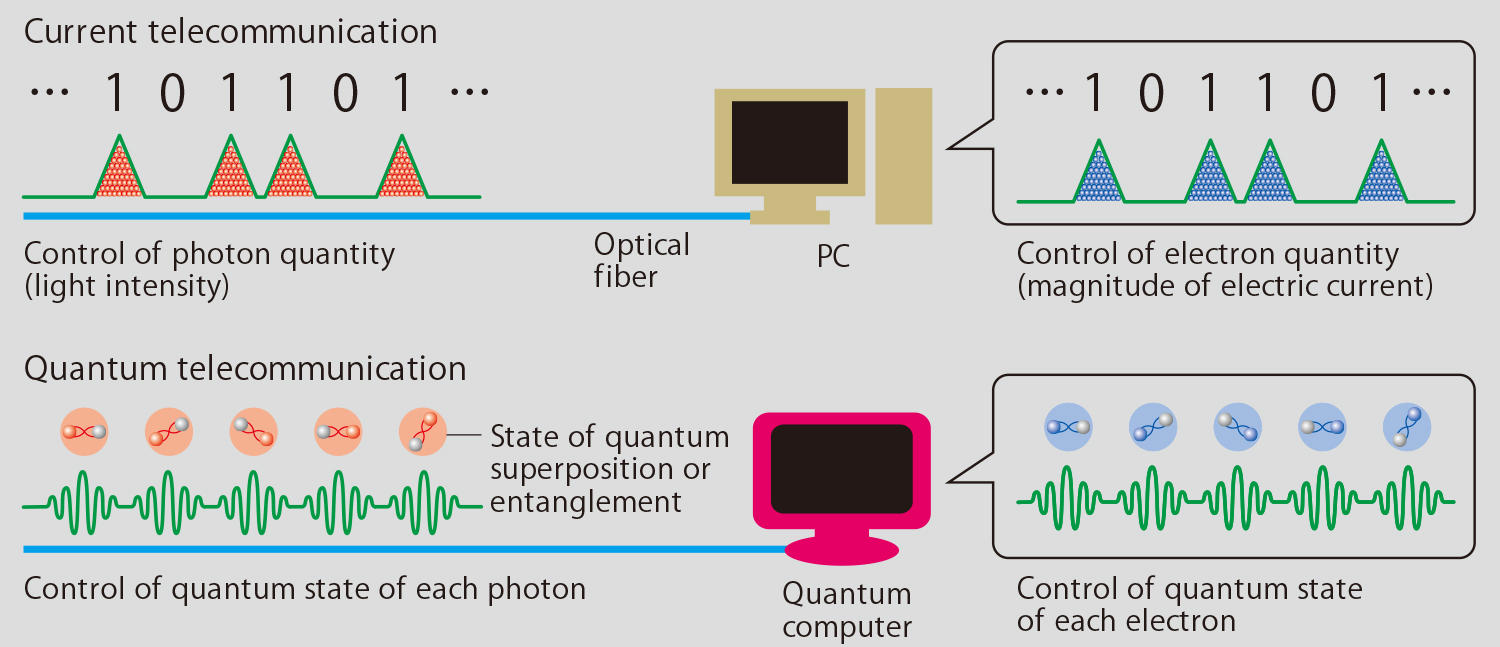
Fig.1 Quantum-based future information technology
With current information technology, information (0 or 1) is represented via control of light intensity (quantity of photons) or the magnitude of electric current (quantity of electrons). By contrast, if we can take advantage of “quantum superposition” or “quantum entanglement,” revolutionary information technologies, such as quantum teleportation, quantum computers, and quantum cryptographic systems will become a reality.
What is “quantum superposition” – a state with 0 and 1 in a state of stack alignment?
As you may know, all information we handle on our PCs, cellular phones, the Internet, and so on is represented by sequences (“01101 …”) of binary numbers of “0” or “1” with a “bit” as the minimum unit (see Fig.1). It is the intensity (ON/OFF) of light or electric current that expresses “0” or “1.” However, this technology merely constitutes a part of the characteristics of light and semiconductors. Therefore, scientists around the world are expecting much of quantum-mechanical informatics. The truly wondrous phenomena of “0 can be 1 simultaneously” that can take place in the world of quantum mechanics are said to enable a new horizon of informatics no one had ever dreamed of previously.
“It is the famous ‘Schrödinger’s Cat’ experiment (Fig.2) that well illustrates the concept of quantum mechanics. In this experiment, a cat is put in Chamber A in which a poisonous gas generating device is set up. On the other hand, with Chamber B, a randomly operating switch is connected to it. When the Chamber B switch is turned ON, the gas generating device in Chamber A is actuated. Until one looks into either one of the chambers after a certain lapse of time, it is impossible to know whether the cat is alive (0) or dead (1). This state is referred to as “quantum superposition” – a state where 0 can be 1 simultaneously. A quantum computer uses this superposition as a unit of information (quantum bit). Since one quantum bit is capable of 0 and 1 processing simultaneously, numerous quantum bits enable super-parallel computation.”
Another important concept is “quantum entanglement.” The cat is alive (A=0) before the switch is turned ON (B=0), while it is dead (A=1) after the switch has been turned ON (B=1). In other words, it is either “if A is 0, B is 0” or “if A is 1, B is 1.” But you cannot tell which is which until you actually observe it. This state is known as quantum entanglement. If Chambers A and B are placed at separate locations, the state of Chamber B becomes definite the moment Chamber A is observed, making it possible to communicate information between two remotely distant locations. This is the principle of quantum teleportation. More than one quantum state, such as superposition and entanglement, remain coexisting possibilities until being revealed. Once revealed, a particular quantum state becomes definite. In other words, this means that quantum states as possibilities are broken once you observe them.
“The photon is useful for cryptography partly because it is the smallest particle that cannot be further divided. It is also because eavesdropping can be easily revealed since quantum states fail if someone attempts to eavesdrop (= observe) on a particular piece of information. Furthermore, the ultimate in energy-saving telecommunication is possible because quantum-mechanical telecommunication works with only an extremely small amount of energy,” Dr. Hayase added.
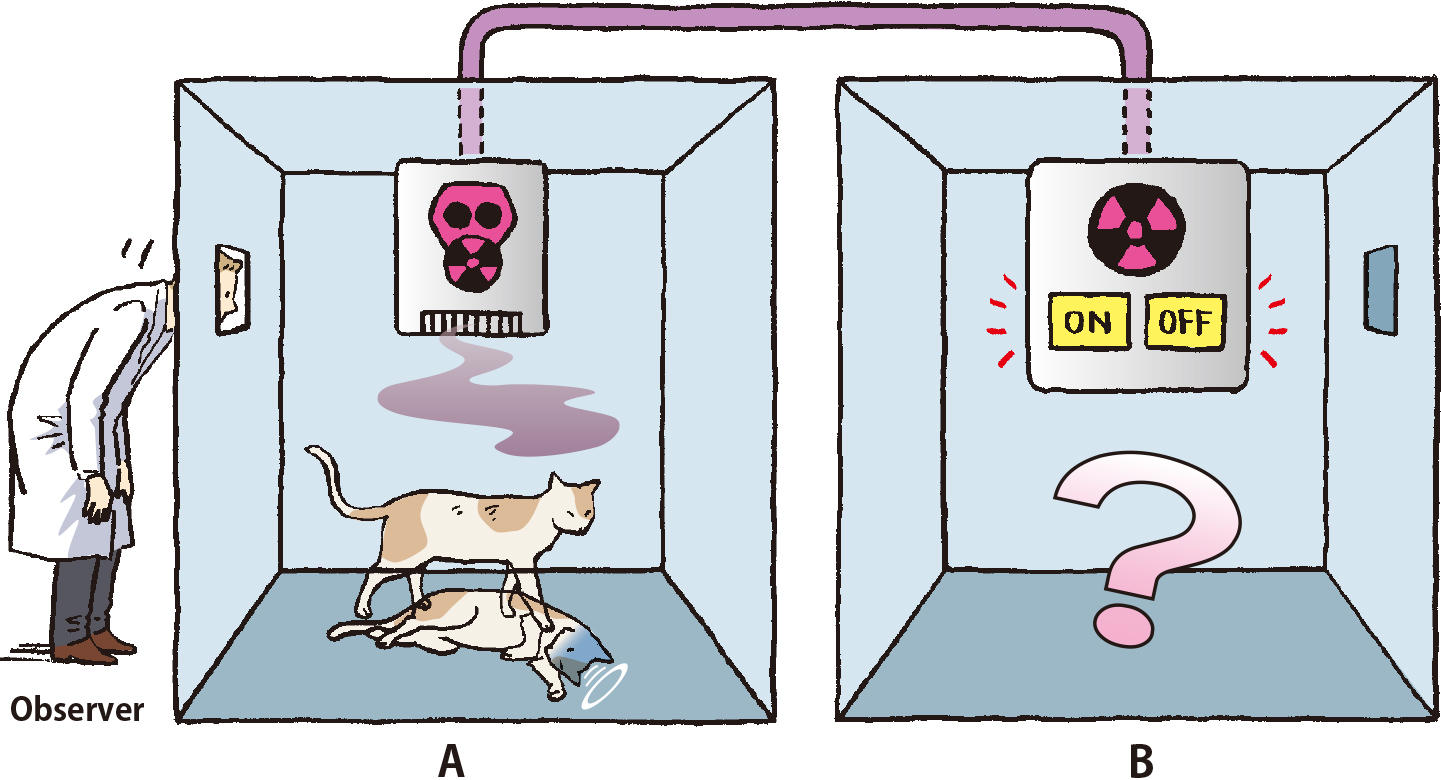
Fig.2 Schrödinger’s Cat
The illustration of the famous ‘Schrödinger’ s Cat’ experiment is an easy-to-understand explanation of the wondrous world of quantum mechanics. Being alive (0) or death (1) of the cat remains unknown until the observer looks into Chamber A – a state known as “superposition.” Also, before the Chamber B switch is turned ON (B=0), the cat in Chamber A is alive (A=0), whereas the cat is dead (A=1) if the switch has been turned ON (B=1), which remains unknown until the inside of either Chamber A or B is checked. This state is known as “quantum entanglement.”
Combining semiconductor quantum dots with ultrashort light pulses
Working energetically to achieve quantum optoelectronics, Dr. Hayase is currently engaged in experiments – exchanging quantum states between semiconductor electrons and photons, controlling these states, and so on (Fig.3). However, numerous problems are encountered to convey quantum - mechanical information to semiconductors.
“A quantum state is so fragile that it can be rapidly broken. Therefore, information needs to be controlled and transferred while maintaining the quantum state, which is extremely difficult.”
Coming to the fore as a possible solution are semiconductor quantum dots – a type of semiconductor suitable for maintaining and controlling quantum states. Quantum dots are ultrafine particles of semiconductor whose size is 10-8 meter. With this semiconductor, electrons can be confined in a very small area, making that area work as if it were an atom. This makes it easy to control and maintain the quantum state of each one of the electrons.
“What’s outstanding about quantum dots is that their characteristics can be controlled freely according to their size and shape. My research team employs a special technique to produce quantum dots that can interact strongly with the light used in optical fiber communication. We have also succeeded in retaining the state of superposition much longer than those developed by other groups.”
That said, it is unavoidable that quantum states are constantly being broken every moment. So, as an ultrafast flash, Dr. Hayase uses ultrashort pulse laser capable of emitting light instantaneously in an incredibly short period of 10-13 second. This enables her team to make use of nonlinear phenomena that cannot take place under ordinary light conditions, which in turn makes it possible to control superposition and quantum entanglement.
Given the extremely weak intensity of light that corresponds to one photon, it is very difficult to cause intended effects between photons and electrons. So Dr. Hayase is looking for a method of collecting many quantum dots that could enhance interactions between photons and electrons.
“What makes quantum mechanics intriguing is that it has virtually unlimited potential. I’m tackling research activities with the hope of achieving a fantastic discovery that could revolutionize the world in decades ahead.”
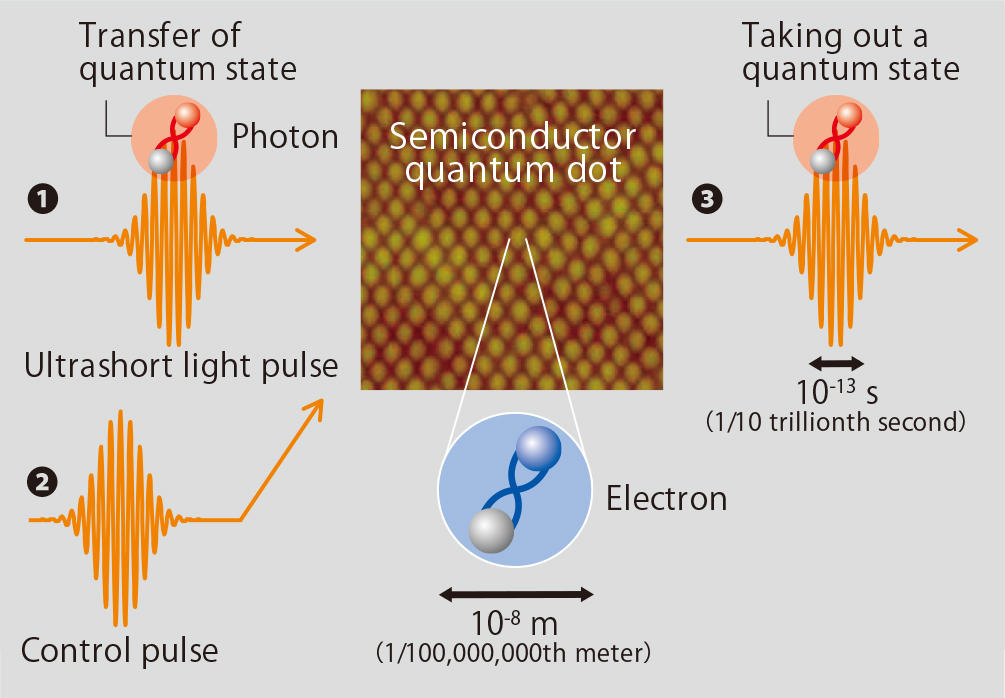
Fig.3 Quantum-mechanical exchange of information between photons and electrons
Photons’ quantum-mechanical information (quantum state) is transferred to electrons within the semiconductor by irradiating ultrashort light pulses to semiconductor quantum dots ❶. After a certain lapse of time, control pulses are irradiated ❷ to allow the transferred quantum-mechanical information to be taken out ❸ in the form of photons.
Interview
Listening to what Associate Professor Junko Hayase has to say
Turning point in my life: an encounter with a high-school physics teacher
How did you spend your childhood? Were you good at science as a young schoolgirl?
Though I have little memory of my childhood, my parents often said that I had been a very inquisitive girl always asking “why?”, but I’m sure I was not particularly good at science.
I was born in Fukushima Prefecture where everything is easy and slow. So I remember that I didn’t study hard as an elementary schoolgirl. In my junior high school days my family moved to Saitama Prefecture and I went on to a prefectural senior high school. An encounter with a physics teacher was inspiring and marked a significant turning point in my life.
Speaking of high-school physics classes, it’s usually the case that students mostly tackle the textbook and solve numerical calculation-oriented problems rather than making physical experiments. But my teacher was different. In our physics class, conducting an experiment was an integral part of study, which made students think about “why.” When it comes to regular examinations, the teacher rarely gave calculation-oriented problems but instead posed questions like “Describe why so.” As a thinking type of student by nature, my encounter with this teacher awakened my interest in physics. That said, becoming a researcher still remained an almost unreachable dream for me back in those days.
This is because as a member of my high school’s rowing club, I had spent most of my time for club activities including participation in the inter-high school rowing competition. Up until September of my third year in high school (when the National Athletic Meet was held), I had literally devoted myself to club activity. So I studied little to prepare for university entrance examinations. Instead, I was admitted via recommendation to the Department of Physics, Sophia University.
But you couldn’t be recommended by your high school unless your day-to-day performance was good, could you?
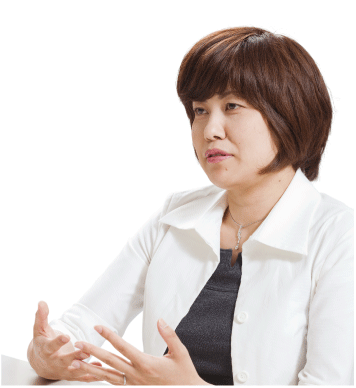
Maybe it was thanks mainly to my increased physical strength and enhanced power of concentration that was developed through my club activities. I used my strength and power of concentration to the fullest to steer through the vital high-school examination. To tell the truth, I had never attended a cram school. And I received a trial university entrance examination only once. The examination I took as a recommendation-based applicant involved no calculation. In fact, it was the so-called thesis type examination in which all the questions given were of the style “Explain such and such.” It was amazingly fit for me (laughter).
Seeking a research career to achieve something innovative
Just about when did you make up your mind to become a researcher?
When I was a senior at my university, I decided to join the lab of Professor Kazuhiro Ema who was then only in his second year of arrival in his post. The lab was focused on nonlinear spectroscopy using ultrashort light pulses – a forefront field of study leading the world. Until the end of the year as a junior, I had learned theories and experiments the answers of which are known and provided. But at the Ema lab we took up the challenges of experiments no one in the world had ever conducted, and could produce innovative results. Since the lab was only in its second year, we had many things to do – improving the facility, setting down rules, making experimental devices, and so on. But doing all these things was both challenging as well as very fulfilling. We often carried out experiments all night long, but it was not troublesome at all. Once concentrated on something, I’m not satisfied until I carry it out to the very end.
Having put myself in such an environment, my yearning to become a researcher must have grown stronger and stronger. People often say that I appear to be a quiet type at a glance, but I find myself rather stubborn and uncompromising once I’ve decided to do something (laughter). My parents advised me, saying “It’s best to find employment with a company after graduation and marry a suitable young man.” But I gave no ear to their advice and decided to go on to graduate school for a doctoral course.
Encounters with good teachers, both in high school and university, turned out to be your vital turning points, right?
I’m now in a position to preside over a laboratory and guide students myself. As such, I can say my experience of having learned under Professor Ema is truly useful. Recalling those days, I don’t remember being severely scolded by Professor Ema. He always encouraged his students and helped them develop their potential by praising good things about each student and giving them advice and research themes that could draw out their motivation. I’m modeling my approach toward students after Professor Ema’s.
After earning my doctor’s degree, I joined the RIKEN institute to become an academic research scientist. It was a position as a postdoctoral fellow with a term of three years. I applied for RIKEN by proposing a research theme of my own, which was luckily adopted by the institute. The theme is a bit different from my current theme, but had things in common in that it would handle light and nanostructured semiconductors. Following my service with RIKEN, I moved to the National Institute of Information and Communications Technology (NICT), where I encountered quantum dots. It just happened that at NICT there was a research team engaging in the making of characteristic quantum dots, which I found intriguing. I belonged to NICT for about four and a half years. With the NICT as well, I obtained a position for myself through job-seeking activity. In our academic world, the acquisition of a doctor’s degree doesn’t necessarily mean a stable employment without term.
Striving under such circumstances, therefore, I approached one research institute after another to obtain necessary research funds and secure a stable research environment. During my service with the NICT, I was successfully chosen as an eligible researcher by the Japan Science and Technology Agency’s (JST) “PRESTO (Sakigake in Japanese)” competitive research funding system that targets individual research projects, surmounting a highly competitive ratio of one in 15 applicants. What was particularly good about the “PRESTO (Sakigake)” system was that the adopted researchers and advisers on the screening side get together in semiannual boarding sessions to engage in discussions in an unrestricted atmosphere. On these occasions, the participants make presentations on the progress of their respective research projects. Each participant is subjected to unreserved opinions and criticism from others – a coveted opportunity for obtaining an extremely high level of advice, which provided me with nourishment for future growth. Being a boarding session, nighttime off the core time discussions was also fruitful and enjoyable as we could talk about each other’s future frankly as late as 2 or 3 o’clock in the morning. In the academic world, human relationships are highly valuable. The fellow researchers I could get acquainted with through the “PRESTO (Sakigake)” system are now a great asset for me.
Using participation in the “PRESTO (Sakigake)” system as momentum for stepping up my career, I then became a teacher for the University of Electro-Communications by taking advantage of thetenure-tracking system (a system that encourages young researchers to accumulate experience as independent researchers under employment with a term and obtain stable employment afterpassing rigid screening). And last year, at last, I could find a permanentposition at Keio University. Inretrospect, I can say that my experience as a postdoctoral fellow with a term, though unstable, was a fruitful one because I could devote myself to research. Now I’m in a position to operate my own lab, with six students, undergraduate and graduate, under my care. I feel great responsibility for this duty, which is fulfilling as well.
You have forged your way always on your own, haven’t you?
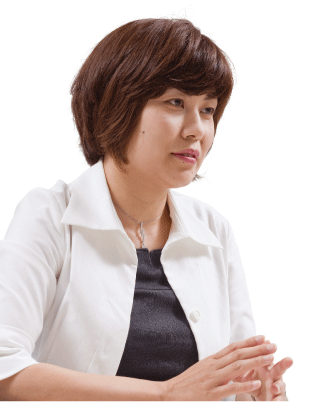
Observers may say I have worked energetically according to my life plan. But I must confess that I’ve merely been pursuing what I liked to do according to the call of opportunity. Now settled in a position without term, I’d also like to take up challenges that take a long time to complete.
I’ve been always natural, not particularly conscious of being “female”.
As a female researcher, have you experienced any particular hardship or benefit?
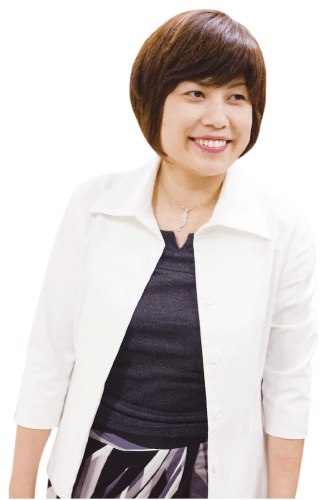
I’m not particularly conscious of advantage or disadvantage in terms of gender because I’ve been surrounded by men since my college days. Most of the time the consciousness as a female didn’t come to mind. Naturally, I always see myself as a person and not as a woman. The only good thing about me being a woman is that as a minority I can be easily remembered by others. I may be also benefiting as a woman because of recently introduced systems aimed to support female researchers. But if I’m benefiting from such systems, I feel obliged to return the benefit I received by producing suitable results. It’s my feeling of responsibility not as a female but as a researcher…
What about diversion from your research work?
Since I’m usually leading a restless life, I try to enjoy a relaxed lifestyle when I’m not working, going shopping with my husband, taking trips and so on. Proper rest and relaxation are definitely necessary because research work demands physical strength and energy as well as power of concentration. Likewise, I’d like my lab students to lead a life punctuated with rhythms of hard work and relaxation.
Just a word from . . .
A student : A student: I’m always impressed with Dr. Hayase’s toughness. Whatever trouble occurs, she comes in punctually and proceeds to research work in a concentrated manner. I admire her as a mirror of research scientists. Just as an attempt to follow her pattern, I’ve begun to develop my physical strength.
(Reporter & and text writer: Madoka Tainaka)


